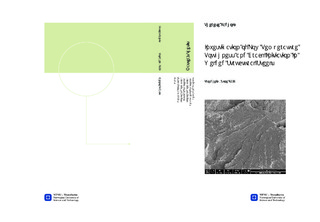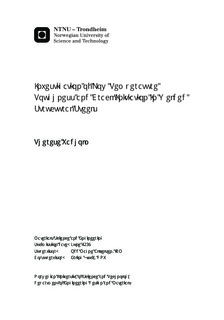| dc.contributor.advisor | Akselsen, Odd Magne | nb_NO |
| dc.contributor.advisor | Ostby, Erling | nb_NO |
| dc.contributor.author | Vadholm, Therese | nb_NO |
| dc.date.accessioned | 2014-12-19T13:28:33Z | |
| dc.date.available | 2014-12-19T13:28:33Z | |
| dc.date.created | 2014-09-13 | nb_NO |
| dc.date.issued | 2014 | nb_NO |
| dc.identifier | 746625 | nb_NO |
| dc.identifier | ntnudaim:11849 | nb_NO |
| dc.identifier.uri | http://hdl.handle.net/11250/249568 | |
| dc.description.abstract | A 420 MPa HSLA steel has been investigated. Instrumented Charpy impact tests and quasi-static CTOD tests have been performed on specimens of weld simulated Coarse Grained Heat Affected Zone (CGHAZ) and Intercritically Reheated Coarse Grained Heat Affected Zone (ICCGHAZ) microstructures. Charpy specimens with both a conventional V-notch and a sharp crack obtained by fatigue pre-cracking have been tested above and below the ductile-to-brittle transition temperature. The aim of the first two parts has been to study the location of brittle fracture initiation sites in samples tested with both conventional V-notch and sharp fatigue pre-cracks. The fracture surfaces of CGHAZ and ICCGHAZ samples with both notch configurations have been examined in a Scanning Electron Microscope and the microstructures have been investigated in an Optical Light Microscope.The transition curves obtained for all combinations of microstructure and notch configurations have been used to evaluate the effect of the blunt notch used in conventional Charpy testing as opposed to the sharp crack used in quasi-static fracture mechanical testing. In addition the effect of testing specimens with weld-simulated microstructures has been evaluated. The last part includes an evaluation of two different correlations that use Charpy impact test values to estimate fracture toughness obtained from quasi-staticfracture mechanical testing. The two correlations include the lower bound relation for lower shelf and lower transitional behaviour described in the British Standard BS7910 and Master Curve approach for the lower shelf transitional behaviour described in the American Society for Testing and Materials standard ASTM E1921.The results show that the fracture toughness of the investigated steel is clearly deteriorated when subjected to welding, and was found to be lowest for the ICCGHAZ microstructure. The deteriorated fracture toughness is linked to the weld microstructures being more heterogeneous and to the MA constituents found in these. Introducing a fatigue pre-crack in the Charpy specimen was seen to have the effect of lowering the fracture resistance in terms of increasing the transition temperature. The difference in fracture toughness between the notched and pre-cracked was found to be largest within the transition region. The upper shelf plateau was found to be lower in the weld-microstructures tested compared to the base material. The scatter was found to be large within the transition region for all combinations of microstructure and notch sharpness, where the CGHAZ microstructure was shown to have the overall largest scatter. The test data was found to be more scattered when testing notched specimens compared to the pre-cracked specimens.Several initiation sites were found close to the notch and fatigue pre-crack in the investigated fracture surfaces. For specimens with a pre-crack, the initiation sites were seen to occur closer to the fatigue crack than in the notched specimens tested at the same temperature for the same microstructure.The notched specimens show a more ductile appearance compared to the pre-cracked specimens at the same test temperature. A ductile region was found in front of the cleavage area in the samples tested at the highest test temperatures.Some of the parameters that can be obtained from the instrumented Charpy data recorded were discussed. These include the energy measured to maximum load, the energy measured to the onset of brittle fracture initiation and the fractions of the total measured energy these energies make. These were linked to the five different curve classes defined for instrumented Charpy curves. The increase in maximum load with curve class number was seen to resemble the increase in the measured CTOD values with temperature. The change in energies to maximum load and to the onset of brittle fracture with temperature were seen to have a shape that resembled the Charpy transition curves. The curve classesobtained at the lowest test temperatures show signs of early fracture initiation. It has been challenging to classify some of these curves. The validity of these curves are also uncertain. This was mainly a result of early fracture initiation where un-dissipated inertia effects leads to oscillations in the measured load.The lower bound relation after BS7910 was shown not shown to provide a good coefficient correlation for the microstructures tested, although conservative results were obtained for the pre-cracked parallels. The Master Curve relation was seen to provide better estimates of the CTOD. The degree of correlation was best for the ICCGHAZ microstructure tested. When using the MC correlation, changing the parameters in the correlation were shown to have a large impact on the degree of correlation. A difference in how the two standards investigated, ASTM E1921 and BS7910, define some of these parameters were also found. A suggestion in using data obtained from instrumented Charpy testing in obtaining new and alternative correlations to estimate parameters obtained from quasi-static fracture mechanical tests from Charpy test data was proposed. | nb_NO |
| dc.language | eng | nb_NO |
| dc.publisher | Institutt for produktutvikling og materialer | nb_NO |
| dc.title | Investigation of Low Temperature Toughness and Crack Initiation In Welded Structural Steels | nb_NO |
| dc.type | Master thesis | nb_NO |
| dc.source.pagenumber | 237 | nb_NO |
| dc.contributor.department | Norges teknisk-naturvitenskapelige universitet, Fakultet for naturvitenskap og teknologi, Institutt for materialteknologi | nb_NO |

